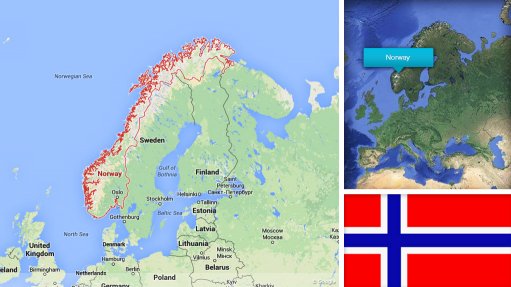
Name: Skaland Operation.
Location: Northern Norway on the Island of Senja.
Mine Owner/s: Skaland Graphite, a 90% subsidiary of Mineral Commodities (MRC).
Brief Description: Skaland is currently the world’s highest-grade operating flake graphite mine and the biggest producing graphite mine in Europe.
Brief History: Graphite was first discovered on the Island of Senja in 1870 and production started in 1917. Graphite was previously extracted from the Skaland mine, which was located directly alongside the existing processing and port infrastructure, but since 2007, ore for the plant has been sourced from the nearby Traelen mine.
Primary Metals/Minerals: Graphitic carbon.
Secondary Metals/Minerals: Not stated.
Geology/Mineralisation: The Traelen deposit is situated on the northern tip of the Skaland peninsula and comprises two main and related lithological units. MRC states that the tectono-stratigraphically lower unit is a banded gneiss, with alternating biotite-rich and granitic bands and an upper unit that comprises amphibolitic gneiss. These are heterogeneous hornblende gneisses with graphite horizons, possibly metamorphic greywacke and calciferous rocks. Both units contain granitic orthogneisses, conceivably as a result of partial melting of the surrounding rocks. Quartz diorites and different types of pegmatites also occur, forming discontinuous intrusions.
The graphite found in the upper unit is presumed to be mostly syngenetic and later exposed to tectonic activity leading to its present textural, mineralogical, geochemical and geometric traits.
The mineralised horizon is isoclinically folded and the thickest. The majority of continuous mineralisation occurs as lens-shaped bodies are oriented parallel to the main fold axis. This horizon contains the most economically interesting instances of graphite at Traelen and can vary between centimetres and 12 m to 14 m thick. There is minor graphite found in faults and along shears. There are minor exploration targets to the south and west of the current Traelen deposit, which may represent either a further fold of the same horizon or a second mineralised horizon.
The rocks in the area have been exposed to at least three phases of folding and deformation, with the last phase responsible for a fold axis dipping 30° to 90° towards the west-northwest. The existence of hypersthene, indications of partial melting and migmatisation and the occurrences of coarse-grained flaky graphite all indicate high-temperature metamorphism.
Reserves: Not stated.
Resources: Total indicated and inferred resources as at December 31, 2020, were estimated at 1.76-million tonnes grading 22% total graphitic carbon.
Mining Method: Longhole open stoping in a bottom-up sequence is used. Longhole open stoping in a top-down sequence is expected in the future.
Flowsheet: Crushed ore from the mine is dumped into a run-of-mine ore bin and conveyed to an autogenous mill followed by a front-end, open-ended milling circuit before processing through a three-stage flotation and cleaner circuit, with multiple substages.
Prospects: MRC has progressed its previously stated medium-term expansion initiatives for the Skaland mine, which will result in a staged optimisation of concentrate grades and increased production from 10 000 t/y to the permitted capacity of 16 000 t/y. This expansion includes:
- the start and optimisation of the mine decline development;
- replacement and modernisation of existing mining equipment, including underground scaling, haulage, loading, blasting and drilling equipment;
- procurement and installation of the fourth stage flotation circuit that significantly improves the product grades (and therefore pricing) of the powder, fine medium and special grade product; and
- the commissioning of a proposed micronised fines circuit and ore sorting facility to help manage tailings discharge limits.
Contact Details:
Skaland Graphite
Tel +61 8 8 6373 8900
Email investor@mncom.au
Website https://www.mineralcommodities.com/